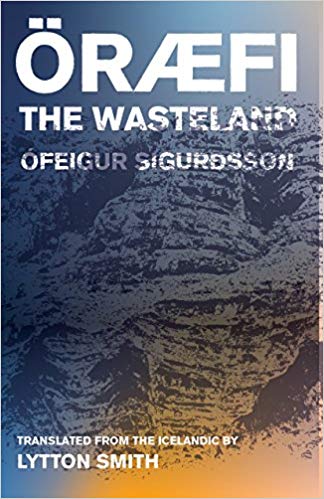Öræfi: The Wasteland
By Ófeigur Sigurðsson, Lytton Smith (Translator)

After a grueling solo expedition on the Vatnajökull Glacier, Austrian toponymist Bernhardt Fingerberg returns to civilization, barely alive, and into the care of Dr. Lassi.
The doctor, suspicious of his story, attempts to discover his real motives for venturing into the treacherous wastelands of Iceland — but the secrets she unravels may be more dangerous than they’re worth.
About The Author: Ófeigur Sigurðsson
Ófeigur Sigurðsson was born in Reykjavík in 1975. He is a graduate of the University of Iceland with a degree in philosophy. He made his poetry debut in 2001 with Skál fyrir skammdeginu (Cheers to the Winter Darkness), and published his first novel, Áferð (Texture), in 2005. Since then, he has published six books of poetry and three novels, in addition to his work as an accomplished translator.
Read an Excerpt
Flosi from Svínafell came back from his vehicle; the angle grinder leapt to life and the hotel splattered with red gore; people felt the mountains dim and the glacier cracking and the sands moaning.
Dr. Lassi was dexterous with the angle grinder, taking the leg off at the asshole and scrotum with swift hacks. It saved the tourist’s life, Dr. Lassi writes a little further on in her report, and it was necessary — because of the acute abscesses, infections, deep freezing and frost and fleshrot and coldburn — to entirely sever one of his ass cheeks, and also his penis; the tourist was then sewn back together with twine sterilized in Brennivín; his asshole was saved, although it would have been safer to take that, too, Dr. Lassi writes in her report, before proceeding to provide a literary survey of the local region…
In 1623, three weeks before Christmas, a water-serpent was seen in the Hvítá two evenings in a row after sunset; the first evening he rose up as two curves across the river, breaking up the ice, so the river flowed on land, the second night the worm rose up in a coil near the middle of Hestfjall; that year a man hanged himself at Hliðarenda, Gísli Jónsson by name; in 1624, a woman hanged herself at Eyjafjall; 1626 at Hliðarenda a boy was whipped and branded, he went and hanged himself; in the winter of 1630 a woman killed herself in Stærra-Árskógur, she was granted burial within the churchyard because her daughter was so mournful; that year a man stabbed himself in Stokkseyri; in 1631, a woman lost her husband in Svarfaðardal, she grieved him angrily, stabbed herself in the neck with a knife until dead, returned to haunt her sister-in-law taking care of her son, ruined everything she had, her specter caused great misery and terror…

Continue Reading…
Article originally Published in the October/November 2019 Issue “Read Global”
